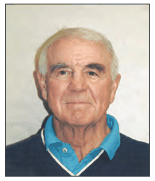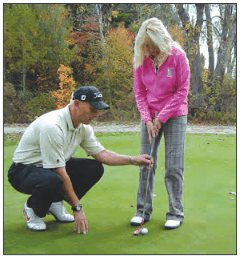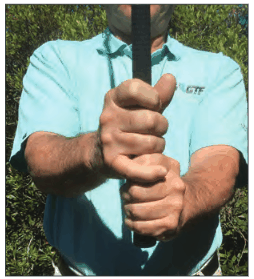Blog
Teaching And Modeling A Winning Mindset
What makes a winner?
Competition is as old as humankind. As civilization has evolved, the types of contests and the means by which victory is achieved in any given endeavor have changed, but the will to win is as strong as ever. From the classroom to the board room, from Little League to the World Series, from the lesson tee to the PGA Tour – winning is the objective of people everywhere. The desire to emerge victorious from any challenge seems embedded in our nature. The intensity of this desire varies according to one’s disposition, personality, experience and motivation, yet our instinct is to give it our best shot, allowing ourselves the optimum chance to come out on top.
“The biggest thing about winning is the desire to succeed,” said Jerry Moore, 2008 U.S. Golf Teachers Cup champion. “Attitude is one thing you have to take into consideration; you can’t be a wanna-be.”
Moore, a retired high school football coach and physical education teacher, is well versed in the concept of winning. These days, he applies that experience to his golf teaching at Neshanic Valley Golf Course, a public facility in Neshanic Station, New Jersey, where he has been for 11 years.
Moore had a saying he used with his football players back in his coaching days: Every day that you don’t do something to make yourself a better athlete, someone will be getting better, and that will put you back a little bit.
What’s the secret to helping a golfer light his or her competitive fire?
“Motivation is intrinsic, but I can teach it,” said Moore, 76. “A player’s objectives must be in line in order to be successful.”
Moore has been involved in athletics all his life. He has observed some young people who could be college golfers but don’t want to make the commitment – they want to play instead of practice. Others aren’t as gifted but are determined to reach tour-level play, so they work extremely hard. Yet as hard as they work, the other guys still beat them occasionally. There are examples of both kinds of players making it on Tour.
“Today is a lot different than yesterday,” Moore said. “Athletes are different.
“We have become a spoiled society. A lot of kids’ work habits aren’t as good as they could be.”
Moore believes that he can get young players to a certain point – and tells them so – but it’s the ones who really want to succeed who probably will do so. As for the others, Moore tries to change their attitudes, employing various examples and methods to encourage the bell to go off in their heads.
“My theory has always been that there is a very fine line between being good and being great, “said Moore. “That line involves a lot of things to get to the big dance.”
An aspiring golfer must be willing to push himself, sacrifice and be a good student and person, with a commitment to diet and fitness.
When Moore won the U.S. Golf Teachers Cup, everything coalesced. It seemed like nearly everything he did worked, giving him the chance to be in that all-important winning position. He’s always been a competitor and has always tried to do the right thing as a teacher – with a serendipitous result.
“I’ve spent so much time working with kids,” Moore said, “that as I got older, I seemed to get better at golf. I was in my sixties when I won the Cup.
“Most of the guys in their twenties and thirties didn’t like that much.”
 USGTF member Dr. Gerald Walford, a retired college professor in sports sciences, as well as a hockey and golf coach, believes that a winning mindset entails the elimination of distractions in order to focus on what is essential. He is an ardent supporter of Zen, in which one learns what is needed – a golf movement, for example – until it becomes muscle memory; then it’s forgotten and becomes automatic.
USGTF member Dr. Gerald Walford, a retired college professor in sports sciences, as well as a hockey and golf coach, believes that a winning mindset entails the elimination of distractions in order to focus on what is essential. He is an ardent supporter of Zen, in which one learns what is needed – a golf movement, for example – until it becomes muscle memory; then it’s forgotten and becomes automatic.
“If you have distractions on your mind – such as the wind, or embarrassment – your neurological connections get mixed up,” Dr. Walford said. “Your eyes and brain get confused.”
Walford believes the secret is not to lose touch with the simplicity of the game. For example, when a golfer hits a putt long, he often hits the next one short, telling himself he has to hit it short – and then he misses it.
“Concentration and discipline all boil down to focusing on the task at hand,” said Walford. “It’s the old adage: one shot at a time.”
Ben Hogan and Moe Norman were two of the greatest ball strikers ever, in Walford’s view. Both were obsessed with golf. Obsession can either make or break you, according to Walford. It made Hogan and Norman.
“All the great players have the obsession to excel,” Walford said, “through hard work, discipline and concentration. It’s not just one thing.”
Walford, who grew up in Ontario, Canada, playing ice hockey, knows a thing or two about hard work.
“Kids need to start young, learning skills mentally and physically through competition,” he said.
As for a winning attitude, Walford has seen countless varieties. Some winners are free and easy, laughing their way to the trophy, while others are deeply serious. Some seem to have no worries, while others fret about performing. Walford believes that no matter an individual’s personality, if that athlete plays his game and eliminates distractions, winning is a real possibility.
“Winning is fleeting,” Walford said. “The great ones last.”
 To Dr. Michelle Cleere, who holds a master’s degree in sports psychology and a Ph.D. in clinical psychology, winners are resilient, able to let go of mistakes and external things that are happening and out of their control – accepting that there is winning and losing and everything in between. And winners commit to both physical and mental preparation.
To Dr. Michelle Cleere, who holds a master’s degree in sports psychology and a Ph.D. in clinical psychology, winners are resilient, able to let go of mistakes and external things that are happening and out of their control – accepting that there is winning and losing and everything in between. And winners commit to both physical and mental preparation.
“Far too often, golfers prepare physically – on the driving range and the golf course – but don’t prepare mentally when they show up to play a round of golf,” said Cleere, 52, herself a competitive athlete. She cited the example of one of the top junior golfers in Canada, whose swing was mechanically very good but who believed that if he simply prepared physically and showed up, “his head would go along for the ride.”
Cleere, who practices psychology in Oakland, California, also noted that over the last 10 years, fitness among golfers has risen in importance. Accordingly, she said, developing a mental game plan is more important too, but only a small percentage of amateur players can do that on their own. Generally, people need assistance and support to get to the place where mental and physical preparation are equally balanced. She teaches students and coaches by modeling positivity, counseling them not to get hung upon their mistakes but rather to talk about things that are going well – in other words, to be focused on the outcome, not the process.
Her approach is to “do it and impart it.”
The anatomy of a winner in golf, according to Cleere, is someone who takes responsibility for his or her own mental game plan.
“You can retrain yourself to think more positively,” said Cleere. “That’s why I love my job.”
 Teaching and competing are what give Mark Harman continued perspective on winning. In both endeavors, he wants to be at his best. Harman, who teaches at Southbridge Golf Club in Savannah, Georgia, has been a USGTF member since 1991 and is the USGTF national course director.
Teaching and competing are what give Mark Harman continued perspective on winning. In both endeavors, he wants to be at his best. Harman, who teaches at Southbridge Golf Club in Savannah, Georgia, has been a USGTF member since 1991 and is the USGTF national course director.
“When I practice and work on my game, I don’t finish until I accomplish what I need to,” said Harman. “And in teaching, I’m always learning.”
Harman subscribes to Bobby Knight’s belief that the will to win is overrated; it’s the will to prepare that is important.
“I go by that,” Harman said. “You can’t just show up and turn on a switch.
“Preparation is key.”
Sometimes a player can’t know where his best achievement level lies, Harman said. Within the professional ranks, many golfers try to improve by changing their technique, with the result that they get worse.
“What seduces golfers is that there’s always something in your head saying, ‘If I can get rid of these mistakes, I can get better,’” said Harman.“ But it’s a seduction you’ve got to avoid.
“You don’t know your best level until after it’s long gone. It’s hard to accept that you never reach perfection in golf.”
Harman believes instructors must teach students confidence and winning ways. Players must be able to put the time into both physical and mental practice. This will lead to belief.
“Belief is so important,” Harman said. “You have to believe you can win, that you have a right to win.” This belief is more realistic for those who prepare conscientiously. Small adjustments can make a big difference. Instructors have to understand what their students’ goals are and be honest with them.
“Students trust me because I’m confident in myself,” said Harman. “It comes with experience.”Students don’t really surprise Harman with their goals, except that they often underestimate themselves.
“They can do better than they think,” he said. “That’s where my encouragement comes in.”
 Master Golf Teaching Professional and 2015 World Cup Senior champion Grant Gulych observed that for his students, the definition of winning varies according to each individual’s goals. For most, winning means hitting the ball more consistently – an attainable goal.
Master Golf Teaching Professional and 2015 World Cup Senior champion Grant Gulych observed that for his students, the definition of winning varies according to each individual’s goals. For most, winning means hitting the ball more consistently – an attainable goal.
“Goals have to be achievable, measurable and specific,” said Gulych, who teaches at two separate public facilities in Ontario, Canada. “The biggest mistake golfers make is failing to have a pre-shot routine.
“Golf is repetition. You have to make sure it becomes a routine.”
Gulych always suggests a routine, which differs with each individual golfer, and three things the golfer needs to improve on. Once those things become habit, he moves on to something else.
In order to instill a winning mentality in his students, Gulych never uses the word “change.” People resist change; it’s human nature. Rather, he tells students he will “adjust” their swing.
“It’s the words you use that determine how students look at you and accept what you are doing,” said Gulych. “I never use ‘no’ or ‘wrong’ – even if the ball is hit only one foot.
“Instead, I tell the golfer he hit it straight.”
Gulych believes that physically, everyone has restrictions, and thus the mental side of the game is more important.
“Most people think golf is eighty percent physical and twenty percent mental,” said Gulych. “I believe it’s seventy percent mental and thirty percent physical.”
Encouraging his students to concur can lead to their improved chances of playing winning golf.
“The more relaxed you are, the better you play.”
Gulych plays golf with his students, usually talking while he’s swinging, so they can focus.
Another technique he uses is that during their second lesson, Gulych asks all his students to hit a driver with their eyes closed, to achieve muscle memory.
“Teachers tend to emphasize the visual: Keep your eye on the golf ball,” Gulych said. “But with your eyes closed, you have to concentrate on the ball.”
“I’ve never had anyone not hit the ball.”
When playing a tournament, Gulych sets three goals for himself: no three-putts, no penalty shots and no double bogeys – worthy goals for any golfer.
“If you meet those criteria, you probably should win the event,” Gulych said. “To me, winning is winning a tournament.”
It took Gulych six tournaments to understand how to play tournament golf, to realize that it’s not at all like playing with one’s buddies. Every shot matters if winning is the objective.
And win he did – by two shots – on his seventh try at the 2013 U.S. Golf Teachers Cup.
“Everything fell together,” Gulych said.
That’s what winning feels like.
When one’s body and spirit – physical and mental aspects – align for a victorious result, the anatomy of a winner has emerged.
Let’s Get Rid Of The Tour Championship
The FedEx Cup is golf’s answer to playoffs, which is supposed to keep up interest after the fourth major is completed. In the past, most people did not care much about golf after the PGA Championship. They even called it the silly season. Enter the FedEx playoffs, a good idea since most people look forward to the playoffs in other sports at the end of their seasonal run. The only problem is that when you get to the finals, there is this Tour Championship which may or may not be won by the playoff champion. It’s all a bit strange.
Even the playoff format is a bit weird. You can miss the cut in the first playoff round and still advance. I think you can advance without playing well if no one surpasses your season-long point total during the playoff run. What kind of system is that? It would be like telling the Yankees even though you lost the first series you can go on because you had the most wins of any team during the regular season. Playoffs should be playoffs. You either move on by making the cut or you’re out.
Here is what I would like to see: First, the Tour Champion should be the winner of the Players. That comprises all the best tour golfers who qualify for it. We don’t need another trophy signifying the same. Then, for the playoffs, the top 125 from the season-long point totals begin the first round. If you fail to make the cut down, you’re out and keep it that way until down to the final 30 players, who would go to East Lake. But that negates the pros who played the best over the long haul, you might say. Okay, then let’s take the top ten and give them a bye for the first round. I mean, the best teams get byes in their respective sports. In a true playoff, anyone who makes it should be able to win. Under the current system, that is very difficult. So, this is what I would like to see. I hope it comes to pass.
Fond Memories Found In-Of All Places –A Range Basket
 I love it when I stumble across something that instantly floods my brain with fond memories of youth. In my basket of range balls, I came across an old golf ball. People are always hitting their old balls on the range trying to get in a few extra shots for free. Just looking at the dimple pattern, I knew it was old, a Wonderball #4 from the Worthington Golf Ball Company of Elyria, Ohio. Now, I doubt that many players today would recognize this brand. However, to a young lad who had to scour the woods and ponds of local muni courses be-cause he was forbidden to raid his father’s golf bag for those precious white orbs, they were a blessing. But that is a whole other story. Although western Massachusetts was Spalding territory, there were plenty of inexpensive Worthingtons to be found.
I love it when I stumble across something that instantly floods my brain with fond memories of youth. In my basket of range balls, I came across an old golf ball. People are always hitting their old balls on the range trying to get in a few extra shots for free. Just looking at the dimple pattern, I knew it was old, a Wonderball #4 from the Worthington Golf Ball Company of Elyria, Ohio. Now, I doubt that many players today would recognize this brand. However, to a young lad who had to scour the woods and ponds of local muni courses be-cause he was forbidden to raid his father’s golf bag for those precious white orbs, they were a blessing. But that is a whole other story. Although western Massachusetts was Spalding territory, there were plenty of inexpensive Worthingtons to be found.
It all began in 1904 when inventor George Worthington obtained the rights to produce a rubber core ball from Coburn Haskell, who had patented the concept of winding rubber strips into a ball which was covered with gutta per-cha. The ball known as the “Bounding Billie” would revolutionize the game, just as the solid gutta percha version did in 1848. Worthington wasn’t the only company to obtain the rights to produce balls, but they produced the best version at the time. As they say, necessity is the mother of invention, Worthington had to be a bit creative with his product. That was because the A.G. Spalding company’s rights included a circular dimple pattern which only they could use.
That did not stop George. He made balls with diamond patterns, pimples in the dimples and a mesh matrix. He also developed his own winding ma-chine that wrapped the rubber strands around a solid core in a more even pattern than any of the other companies who were hand-winding their balls.
Over the next 50 years, the Worthington Golf Ball Company became one of the largest supplier of balls in the world. They were the first to produce a liquid-center ball, first to develop hardness and compression tests, and first to produce a white-covered ball with a one-piece dip process. In 1910, Worthington came out with the “Radio” ball, with a center containing radium particles. No one knew what it did, but because of Madam Curie’s work with radium at the time, radium was all the rage. The company was truly innovative, thanks to George. After World War I, he developed the first balata-covered version. For the interior, he would freeze the core before winding, which made the ball harder and tougher. He even x-rayed the balls for trueness.
When World War II broke out, the government sent word out to companies that no more golf balls were to be manufactured for the duration of the war. That did not stop Worthington. He began reprocessing old balls. Had it not been for his efforts, golf may have gone by the wayside. Fortunately, the Surgeon General’s Office saw the health benefits of golf and the government offered manufacturers synthetic material, and true to form, Worthington develop a synthetic golf ball that was shipped all over the world wherever servicemen were stationed. After the war, the company continued to thrive and try many new processes and materials, expending considerable research in the ball production.
Unfortunately, the Worthington brand is no longer around today except for those found in golf range baskets or on a golf collector’s trade show table. The company was absorbed in 1966 by the Victor Comptometer Company and moved to Illinois. Vic-tor brand morphed into the PGA Company, which eventually became Tommy Armour Golf that now is sold by Dick’s Sporting Goods, which acquired it from Sports Authority. Gone but not forgotten by a young lad who came to love a game that required a precious pearl called “Wonderball.”
Mike Stevens is the Southeast Region director of the USGTF and golf teaching pro at MacDill Air Force Base in Tampa, Florida. He is the 2005, 2010 and2012 National Hickory champion and the 2004U.S. Golf Teachers Senior champion. He also owns and operates the Mike Stevens on Target Golf School in Tampa.
A Closer Look At The Three Main Grips
Actually, you may be surprised to learn that a number of golf teaching professionals (mainly non-USGTF members) do not know how to properly teach the grip, nor do they have a firm understanding of the cause and effect associated with the three grips. Our USGTF examining staff has found more than one teaching professional who has been teaching without certification or who belongs to another organization who doesn’t know as much as they should about teaching the grip. So if you’re comfortable in your knowledge and abilities in teaching the grip and knowing its nuances, please consider this article as a refresher or confirmation. But even then, hopefully there is a nugget or two which you may take away.

Overlapping grip
This is the most commonly used and taught grip by playing and teaching professionals. This likely came about due to the influence of Harry Vardon, who popularized the grip as a way of taking some of the right-hand action out of the swing and therefore lessen the possibility of a hook. Because traditions and long-held schools of thought die hard in golf, it’s likely most teaching pros simply passed along the overlap grip as the preferred grip due to tradition. But is it really the “best” grip?
The best grip is the one which allows the golfer to return the club square the most consistently. It’s been said that every good golfer has fought a hook some-time in his or her career, so the anti-hooking features of the overlapping (or Vardon) grip are very useful to the majority of such golfers. In fact, Jim Furyk uses a double-overlap grip because of his propensity to use a lot of hand action through impact, which further promotes a hook. But that brings us to an obvious question: If the overlapping grip is an anti-hooking grip, why should we teach slicers this grip?
Hopefully our instruction will result in slicers no longer being slicers, and due to the relatively small grip a golf club possesses (in relation to others sports like baseball and tennis), it’s easy for excessive hand action to become an issue for more competent players. Thus, the overlapping grip is a good choice for these players. It also seems to allow the player to more easily put the club in the correct position in the trail hand as compared to the other grips, al-though obviously this doesn’t necessarily hold true for everyone.

Interlocking grip
The most famous practitioners of the interlocking grip include Jack Nicklaus, Tiger Woods and Rory McIlroy. Nicklaus touted the grip as being more appropriate for golfers with shorter fingers, but a number of players who don’t have shorter fingers also use the grip…and a number of players with shorter fingers also use the overlapping, so this rule of thumb doesn’t seem to be very hard and fast. (Remember, traditional thought in golf instruction tends to stick around, regardless of whether it’s accurate or not.)
Dr. Ralph Mann, a biomechanics expert who has researched golf technique to a greater degree than most, believes the interlocking grip is problematic because it allows the golfer to grip the club too much in the right palm(for right-handed players) if the golfer is not careful to avoid this.
The practical differences between the overlapping and the interlocking grip are negligible, to the point that one or the other is fine for players who choose not to use a 10-finger grip.

10-finger grip
This also known as the “baseball” grip due to its similarity to holding a bat, with no overlapping of the fingers. Major champions such as Art Wall and Bob Rosburg used the grip on their way to victory, so it has stood the test at the highest level of the game. Moe Norman, renowned for being the greatest ball striker ever, switched to the grip later in his career.
Earlier, we asked the question of why we would want our students who slice to use an anti-hook grip such as the overlap. It’s a good question, and if we have students whose tendency is to hit slices, the10-finger grip may be the best option to eliminate or mitigate the problem. Even a slight separation of the hands may be necessary to reduce slicing in some students.
Some teachers like to advocate that junior players use the 10-finger grip, with the goal of switching to the overlap or interlock later. This is feasible, as kids usually adapt swing and setup changes fairly easily as compared to adults. People with weaker hands and forearms may also benefit from the 10-finger grip. Finally, golfers who use larger arthritic grips may experience that the overlap or interlock is difficult to incorporate with such grips, finding that the 10-fingergrip offers a greater ease of use.
The USGTF Technical Committee’s official position on which grip to use is that it is up to the player and their judgment of comfort and playability. The committee has found, through its own teaching experience, that the interlocking grip seems to be a more natural grip for most people to use as compared to the overlapping, but this may be due to the factor that Dr. Mann described, which is it allows the player to hold the dominant hand grip more in the palm. This feeling is undoubtedly more secure for many players, but it represents a false security as it restricts the proper movement of the club throughout the swing.
Golf teaching professionals usually have little reason to change the type of grip their students are using, but in some cases a change may be for the better. Knowing the pros and cons of each grip can help the teacher make the correct call.
Friendship VS. Competitors
Recently, after Jordan Spieth’s and Justin Thomas’ major wins, much has been said in regards to their friends being part of the celebration. It just so happens that these “friends” are other players on the Tour and can be found on the 18th green cheering on their buddies to victory. This has been a hot topic within the golf community. Is it good or bad for the game?
Some might say this behavior is abnormal. We never saw Tiger waiting around to congratulate Phil, or vice versa. I don’t think we ever will. The media wanted to play a “villain vs. hero” during that era. We don’t know if there was bad blood between them or not; it’s purely speculation.
With the introduction of social media, we are given a glimpse into the daily lives of today’s professional athletes. There is a friendship between many of the younger PGA Tour players: Spieth, Thomas, Fowler, Berger and Kaufman, to name a few. Their posts on social media often show them hanging out off the tour, even taking vacations together. They have a true bond of friendship; they want each other to succeed and are sincerely happy to celebrate their wins.
To me, this is great for the game. It shows that inside the ropes you can try to beat your friends and strive to win. However, once the game is over, true friendships are made, and it’s okay to celebrate one another’s successes. It helps strengthen the game and teach the younger generation how to carry oneself both on and off the course.
At the end of the day, all players want to win and compete at the highest level. Sometimes your best isn’t good enough. Being able to look across at your opponent and tell them great job while shaking their hand is a crucial part of the game that needs to live on. This gentleman’s game of today is also proving to be a game to be shared amongst friends.
New Times, New Terms
With the advent of high-tech gadgets and increased knowledge, different terms have come onto the teaching scene. While they may not be new, there may be a new understanding of how they work or what they are.
TrackMan® and FlightScope®. These are Doppler-radar based launch monitors that mea-sure every relevant aspect of ball flight. They have “launched” (pun intended) a whole new slew of terms in recent years. Among them:
Launch angle. This is the angle the ball takes off compared to the horizontal ground, measured in degrees. For drivers, anywhere from 10°for higher swing speeds to upwards of 16° for lower swing speeds are what club fitters and teachers are looking for.
Spin axis. A ball that has backspin around a perfectly horizontal axis will have no curvature. The amount that the actual axis varies from horizontal is called “spin axis” and is measured in degrees. If the axis tilts to the left of horizontal (as seen behind the target line), the ball will have draw spin for a right-hander, and if it tilts to the right of horizontal, the ball will have fade spin.
 Example of spin axis of a draw (right-hander)
Example of spin axis of a draw (right-hander)
Zero out. This is launch monitor parlance for having a club head path at impact that is towards the intended target with a square clubface.
Positive/negative angle of approach. In the old days we would say ascending (positive) or descending (negative), but since launch monitors use positive or negative numbers, the terminology is going in the numerical direction.
Smash factor. This is the ratio of ball speed to club head speed. With the driver, most clubfitters believe that a smash factor of at least 1.45 is necessary to call a driver a good fit for that particular person.
RPMs. This is the number of revolutions per minute of the ball’s backspin. For drivers, RPMs that vary from 2,200 to 2,800, depending on ball speed and launch angle, are desirable. With the increased technology in drivers available to manufacturers, they are able to do more to make this happen. It has been said that the holy grail for driver launch is 17° of launch angle with 1,700RPMs of spin. Time will tell if a driver can be made to make this feasible.
Teaching and coaching. New terms, and older terms that are now more commonly in use, have made their way onto the stage.
Covering the ball. This term is not new but has been used extensively in recent years. It means not tilting the chest backwards coming into impact and letting it rotate so that the player does not swing too far inside-to-outside. This is mainly a good player’s feel as it is one to help a player from hooking the ball.
Save the shot. Again, mainly a good player’s fault. This results from a swing path that is in-side-to-outside during impact, resulting in a push unless the player “saves” the shot by precise timing of the release of the hands.
Fall line. This term has been made popular by Johnny Miller on television. It refers to the putting green. A ball rolling on the fall line towards the hole will go dead straight. Determining if the ball lies to the left or right of the fall line is helpful in figuring which way the putt will break, and seems to be the preferred greens-reading method for many tour players today, rather than just looking at the slope of the green between the ball and the hole.
Center of mass vs. swing pressure. Some teachers employ foot pressure plates, which measure how much each foot is pressing into the ground at any given time. This is different than the center of mass, a completely different subject. It is possible to have most of the pressure on the rear foot, for example, at the top of the backswing while having the center of mass more forward. One of the trends in teaching today is to have the center of mass stay relatively stationary throughout the swing (at least through impact).
Use the bounce. This has been known for years with bunkers shots, but now it is becoming more common for pitch shots. More wrist action through impact and/or a shallower angle of attack make this happen. Many teachers feel this lessens the chance of a mishit, especially hitting fat shots.
Golf terms continually evolve, and it is certain that terms that will be used in the years to come have not even be invented today. Although the game continues to change, it holds deep to its traditional roots, and this combination means the game will appeal to people of all types for the indefinite future.
New Videos Featured Online as Part of Refresher Course for Current USGTF Members
Smith Wins USGTF Central Region Championship
Grant Gulych from St. Thomas, Ontario, finished in second place with a fine showing of 74-72 – 146. Fellow Canadian Dan Estevan from Georgetown, Ontario, finished third with scores of 82-69 – 151. Estevan’s final round featured six birdies as he had the low score of the day.
Harvey Penick Award Nominations Being Accepted
The award is based on teaching accomplishments, service to the golf community and to the game in general. All USGTF Certified Golf Teaching Professionals and Master Golf Teaching Professionals, except past winners, are eligible. Nominations (including self-nominations) may be made through email at info@usgtf.com or through regular mail to the USGTF National Office at 1295 SE Port St. Lucie Blvd., Port St. Lucie, FL 34952. The deadline for nominations is Friday, September 15, 2017 at 5:00 p.m. EDT.







